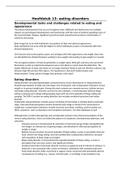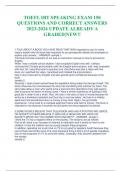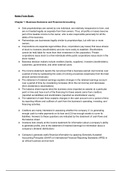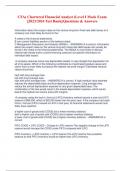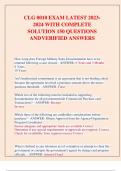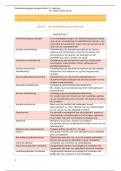Hoofdstuk 13: eating disorders
Developmental tasks and challenges related to eating and
appearance
The physical development that occurs throughout later childhood and adolescence has multiple
impacts on psychological development and functioning, with the onset of puberty signalling many of
the most dramatic changes. Significant growth involves proportional increases in food intake of
nutrients and energy.
Body image has to do with individuals’ perceptions of their own physical appearance.
Body satisfaction has to do with the degree to which individuals accept or are pleased with their
physical appearance.
Girls become more preoccupied, upset, and unhappy with their appearance and weight. Boys who
are dissatisfied are divided between wanting to lose weight and wanting to gain weight (or muscle).
The strongest predictor of body dissatisfaction is weight status. Both girls and boys who perceived
themselves as late in pubertal development were more likely to report body dissatisfaction. The
largest differences in body size ideals are no longer between Western and non-Western cultures, but
between high-SES and low-SES regions. The hypothesis is that both modernization and
Westernization “bring cultural changes that promote a thin ideal”.
Eating disorders
Eating disorders are psychopathologies characterized by severe disturbances in eating behaviors,
disturbed perceptions of body size and shape, fear of being fat, and compensatory behaviors to lose
weight or to prevent weight gain. Among the most common are anorexia nervosa, bulimia nervosa
and binge eating disorder. Anorexia nervosa has two subtypes: a restricting type (without binge
eating or purging) and a binge eating/purging type (with recurrent episodes of binge eating and
purging). The DSM-5 section on eating disorders also includes avoidant/restrictive food intake
disorder.
Problematic eating behaviors include severe restricting of food intake or limiting food to particular
types. Distorted body perceptions involve distorted body image or denial of the seriousness of
weight loss. Compensatory behaviors include excessive exercising, vomiting, and/or laxative use.
Other symptoms, such as obsessions and compulsive behaviors, are often displayed as well.
Although there is both heterogeneity and considerable overlap in the clinical presentations of the
various eating disorders, there are distinctive patterns of symptoms, developmental pathways, and
outcomes.
- Anorexia nervosa is characterized by restriction of food and energy intake and significantly
low weight, an intense fear of gaining weight, and disturbed or distorted perceptions of
weight or shape.
- Bulimia nervosa involves recurrent episodes of binge eating, a sense or perception that one
lacks control over binge eating, recurrent problematic compensatory behaviors, and poor
self-evaluations of body shape and weight.
- Binge eating disorder is characterized by repeated episodes of binge eating, a sense or
perception that one lacks control, and significant distress.
- Avoidant/restrictive food intake disorder involves an apparent lack of interest in eating or in
food that is not associated with a drive for thinness. Individuals with avoidant/restrictive
food intake disorder either avoid food or appear overly concerned with potentially adverse
consequences of eating (e.g., nausea, stomach pain, or vomiting). Food avoidance may
, involve aversion to the texture or smell of food. Individuals with avoidant/restrictive food
intake disorder display significant weight loss, nutritional deficiencies, and/or impaired
psychosocial functioning.
The prevalence of eating disorders has increased over the past several decades. Available statistics
from the National Institute of Mental Health show overall prevalence rates of 2.7% for eating
disorders for 13- to 17-year-olds, with girls two and a half times as likely as boys to have an eating
disorder. The average duration of an eating disorder episode was approximately three months for
bulimia and 11 months for anorexia.
Crossover is common in eating disorders. Many individuals are first diagnosed with bulimia, and then
cross over to anorexia. Adolescents diagnosed with eating disorders are also frequently diagnosed
with other psychopathologies. Depression and anxiety are common comorbid disorders. There is also
considerable overlap between eating disorders and bipolar disorder, and symptom similarities in
terms of eating dysregulation, mood dysregulation, impulsivity, and compulsions. Self-harm and
suicidality are primary concerns for people with eating disorders.
Developmental course
Eating disordered behavior in childhood and adolescence predicts eating disordered behavior in
adulthood, although there is a decline in prevalence and in severity. Further, being diagnosed with an
eating disorder in childhood or adolescence is associated with later risk of being overweight and
worse mental health outcomes. Eating disorder onset is most common at two times: early
adolescence and late adolescence. These are two key developmental transition points. The first one
marks the transition from childhood to adolescence, and the second is from adolescence to
adulthood.
There are multiple risk factors, including body dissatisfaction, perceived pressure to be thin, thin-
ideal internalization, and negative affectivity, are already in place by puberty and escalate in impact
over adolescence. The developmental pathways of eating disorders are varied. Younger adolescents
are more likely to present with symptoms of anorexia nervosa, and older adolescents are more likely
to present with symptoms of bulimia. Many adolescents exhibit fluctuating courses of weight loss
and gain, whereas others deteriorate over time and are repeatedly hospitalized. The psychological
consequences of eating disorders include impairments in self-image, health, and social functioning. In
addition, there are immediate and long-term medical complications, such as biochemical, endocrine,
haematological, and bone-related difficulties. The mortality rate for eating disorders is high.
Etiology
Two of the most well-known explanations of eating disorders are related to family factors and
sociocultural factors. Internalization of the thin ideal, coupled with the pressure to be thin (coming
from oneself, family, peers, and society), leads to body dissatisfaction, negative emotions,
problematic dieting behaviors, and eating pathology.
Genes and heredity
Family and twin research suggests strong heritability for both anorexia and bulimia. Nonshared
environmental factors (i.e., those factors that differentially influence siblings) are much more
important than shared environmental factors.
Physiological factors
- Abnormal activity in various regions of the brain, including the prefrontal and temporal
lobes.
, - Dysregulation of eating and mood, impulsivity, and craving responses after exposure to food
cues
- Dysregulation of reward circuits with activation of brain and hormonal stress responses these
changes in the entire brain-body system underlie ongoing risk, chronic distress and
impairment, and frequent relapses.
- Puberty is associated with increased risk. Part of that increased risk is linked to physiological
maturation and hormonal changes
- Early-maturing girls are at higher risk than later-maturing girls.
- For children who struggle with obesity in childhood, there are increased risks for restrictive
eating disorders in adolescence.
Child factors
A cluster of biologically influenced personality characteristics have been identified that increase
vulnerability. These include temperament, negative emotionality and emotion dysregulation,
impulsivity, stress reaction and harm avoidance, and reward and punishment sensitivity.
Perfectionism, involving setting impossibly high goals and experiencing a sense of failure and
worthlessness when those goals are not met, appears to run in families and may lead to the
relentless pursuit of the thin ideal. Perfectionism is central to both etiology and maintenance
processes.
Individuals with anorexia described lower levels of agency and relatedness, as well as heightened and
harsh self-reflectivity. There is also atypical emotional development and functioning (such as a
reluctance to express emotion or a tendency to experience a restricted range of emotion).
Body-related characteristics and attitudes are another set of risk factors, with body dissatisfaction at
the nexus. Several risk factors are present before puberty and increase in salience across
adolescence: perceived pressure to be thin, thin-ideal internalization, body-mass index, dieting,
negative emotionality, and body dissatisfaction. Body dissatisfaction is the most consistent and
strongest predictor of eating disorders later in life.
Teasing appears to be a particularly important factor for both girls and boys. A different type of body
risk factor involves participation in weight-focused sports, such as gymnastics or running.
Parent and family factors
One basic risk variable involves general family dysfunction. For instance, families with more
problematic communication, more psychopathology, and more financial difficulties have adolescents
at higher risk.
Encouragement of dieting is also related to body dissatisfaction and drive for thinness. Fathers who
emphasize attractiveness and control food intake increase the risk of eating pathology. Fathers, as
well as mothers and siblings, who tease daughters increase the likelihood of negative outcomes.
Paternal rejection is an especially poignant risk factor.
Family connectedness, positive family communication, and parental monitoring all decrease the risk
of eating disorders in adolescents.
Environmental factors
Negative life events increase the risk for eating disorders and may trigger the onset of an eating
disorder. Media influences are also important risk factors.
Assessment and diagnoses
, The assessment and diagnosis of eating disorders involves the developmentally informed evaluation
of a complicated mix of somatic and psychological symptoms. Assessment may be especially
problematic because most adolescents with eating disorders deny difficulties (often vehemently) and
avoid contact with medical or mental health professionals. The development and maintenance of
therapeutic engagement and alliance, therefore, are of the highest priority.
Intervention
Interventions for eating disorders include both prevention and treatment.
Prevention
Prevention strategies frequently target some of the more malleable risk factors, including body
dissatisfaction, negative emotion, and internalization of the thin ideal, and seek to strengthen some
of the protective factors, such as self-esteem and social support. School-based programs in both
middle schools and high schools, as well as across ethnic groups, can be effective. These may focus
on components of healthy eating and healthy dieting, self-esteem and perfectionism, and critical
analysis of media images, and may specifically address teasing and harassment related to body
weight and shape. Age 14 appears to be the key age for prevention efforts.
Treatment
Treatment models include inpatient hospitalization, partial hospitalization, intensive outpatient
settings, and traditional outpatient settings. Current approaches provide multidisciplinary,
comprehensive, and integrated treatments that address the medical and psychological issues of
children, adolescents, and their family and peer contexts.
There is little evidence that pharmacological treatments are effective for restoring weight for
individuals diagnosed with anorexia, and mixed data on the role of pharmacological treatments for
reducing relapse rates and improving core features of eating disorders.
Family involvement appears to be useful in reducing both psychological and medical morbidity,
especially for younger patients with a short duration eating disorder. Parent participation is also
associated with lower rates of dropout for adolescents.
- In the Maudsley model of family therapy parents have a central role in treatment. The
Maudsley model is a “highly practical approach, which initially focuses exclusively on
problems related to improving eating and promoting weight gain”. In the early phase of
treatment, parents have significant control over the adolescent’s eating; problems in family
structure that make improvements in eating more difficult are addressed quickly. When
eating and weight have improved, adolescents take more responsibility and control over
eating. The last part of treatment focuses on the typical developmental challenges of
adolescence (e.g., autonomy, sexuality) that may have an impact on continued progress.
Compared to individual treatments for adolescents with anorexia, family-based treatments were
more effective in maintaining full remission of symptoms over time
The most common, empirically supported individual approach is cognitive-behavioral psychotherapy.
A specialized version, cognitive behavioral therapy for eating disorders (CBT-E), is designed to
address various forms of eating disorders and to match adolescents’ and young adults’ personalities
and psychopathologies. The focus of CBT-E treatment involves identifying factors that maintain the
eating disorder (in contrast to factors that influenced the development of the disorder), and helping
individuals step back or distance themselves from their disorder so that they can understand it
better.
Interpersonal therapies, focused on changing the problematic relationships that trigger or maintain
eating disorder symptoms, have received empirical support. Of course, it is essential to address

